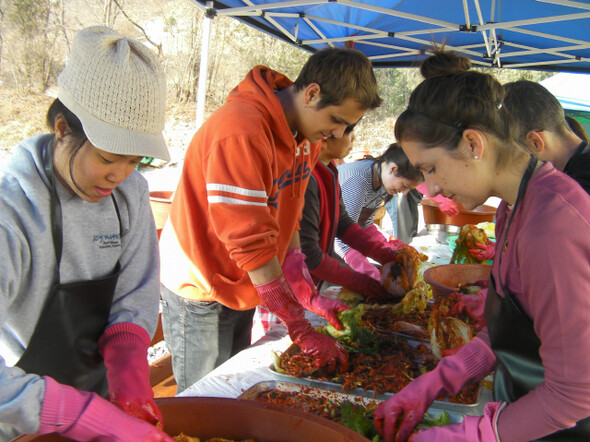hankyoreh
Links to other country sites 다른 나라 사이트 링크
Johns Hopkins students learn about Korea through kimchi making

By Kim Min-kyung
Gongi-dong, a village of some 70 families and 100 inhabitants located by Mt. Worak in Salmi Township, Chungju, North Chungcheong Province, saw more international individuals than any time since the Korean War on Sunday morning. The visitors were students at the Johns Hopkins School of Advanced International Studies taking a course titled “The Two Koreas” from Professor Jae-jung Suh. The ten graduate students had come to the village to make kimchi. Outfitted in rubber gloves, boots, and aprons, they began the process in earnest by using water to clean cabbage that had been pickled in salt the previous evening.
All were proficient enough with chopsticks to be able to use them to eat kimchi, but they said this was the first time they actually tried making it themselves. Their arms and clothes were covered in kimchi seasoning, but they laughed throughout from enjoyment of the process. By their sides were “veterans,” elderly women from the village who instructed the students in a seasoning preparation method based on decades of know-how.
Suh, the leader of the group, has been taking part in the gimjang, kimchi-making process, with U.S. graduate students in his class since last year. The students arrived in South Korea on Saturday for a one-week trip sponsored by the school. The ten kilograms of kimchi made on Sunday filled nineteen boxes. The boxes were then taken directly to Nanum House, a home for living “comfort women” who were forced to become sex slaves for the Japanese military during World War II, located in Gwangju, Gyeonggi Province. The students themselves paid for all of the materials.
While making the kimchi, the students naturally came to discuss issues such as the plight of the comfort women and the skyrocketing cabbage prices in South Korea.
“I did not think of it as simply for making kimchi, but for making something better than that, which was really enjoyable,” said Jeanette Lee, 31, who participated in Sunday’s event. “I would like to know more about the experiences of the comfort women and their lives after their experience.”
Choe Na-rae, a 24-year-old U.S. exchange student, said, “Normally, the students at the School of Advanced International Studies are mainly interested in things like politics and the economy, and they do not know a lot about Korea’s past.”
“I think coming to Korea and making and delivering kimchi themselves helped them to develop more of an interest in history, such as the comfort women issue,” Choe added.
The event Sunday was part of the “Mt. Worak Gongi-dong Kimchi Preparation and Sharing,” a program organized by researchers at the Institute for Research in Collaborationist Activities. The program makes kimchi deliveries to the descendants of independence fighters who are disadvantaged due to poverty, former “comfort women”, victims of forced mobilization and military conscription by the Japanese Empire, and family members of living and deceased participants in the South Korean democratization movement.
Please direct questions or comments to [englishhani@hani.co.kr]
Editorial・opinion
![[Guest essay] Preventing Korean Peninsula from becoming front line of new cold war [Guest essay] Preventing Korean Peninsula from becoming front line of new cold war](https://flexible.img.hani.co.kr/flexible/normal/500/300/imgdb/original/2024/0507/7217150679227807.jpg) [Guest essay] Preventing Korean Peninsula from becoming front line of new cold war
[Guest essay] Preventing Korean Peninsula from becoming front line of new cold war![[Column] The state is back — but is it in business? [Column] The state is back — but is it in business?](https://flexible.img.hani.co.kr/flexible/normal/500/300/imgdb/original/2024/0506/8217149564092725.jpg) [Column] The state is back — but is it in business?
[Column] The state is back — but is it in business?- [Column] Life on our Trisolaris
- [Editorial] Penalties for airing allegations against Korea’s first lady endanger free press
- [Editorial] Yoon must halt procurement of SM-3 interceptor missiles
- [Guest essay] Maybe Korea’s rapid population decline is an opportunity, not a crisis
- [Column] Can Yoon steer diplomacy with Russia, China back on track?
- [Column] Season 2 of special prosecutor probe may be coming to Korea soon
- [Column] Park Geun-hye déjà vu in Yoon Suk-yeol
- [Editorial] New weight of N. Korea’s nuclear threats makes dialogue all the more urgent
Most viewed articles
- 1Behind-the-times gender change regulations leave trans Koreans in the lurch
- 2South Korean ambassador attends Putin’s inauguration as US and others boycott
- 3Yoon’s revival of civil affairs senior secretary criticized as shield against judicial scrutiny
- 4Family that exposed military cover-up of loved one’s death reflect on Marine’s death
- 5AI is catching up with humans at a ‘shocking’ rate
- 6Yoon’s broken-compass diplomacy is steering Korea into serving US, Japanese interests
- 7[Guest essay] Preventing Korean Peninsula from becoming front line of new cold war
- 8Japan says its directives were aimed at increasing Line’s security, not pushing Naver buyout
- 91 in 10 marriages in Korea last year was with a foreign national
- 10[Column] The nuclear umbrella and the afterlife